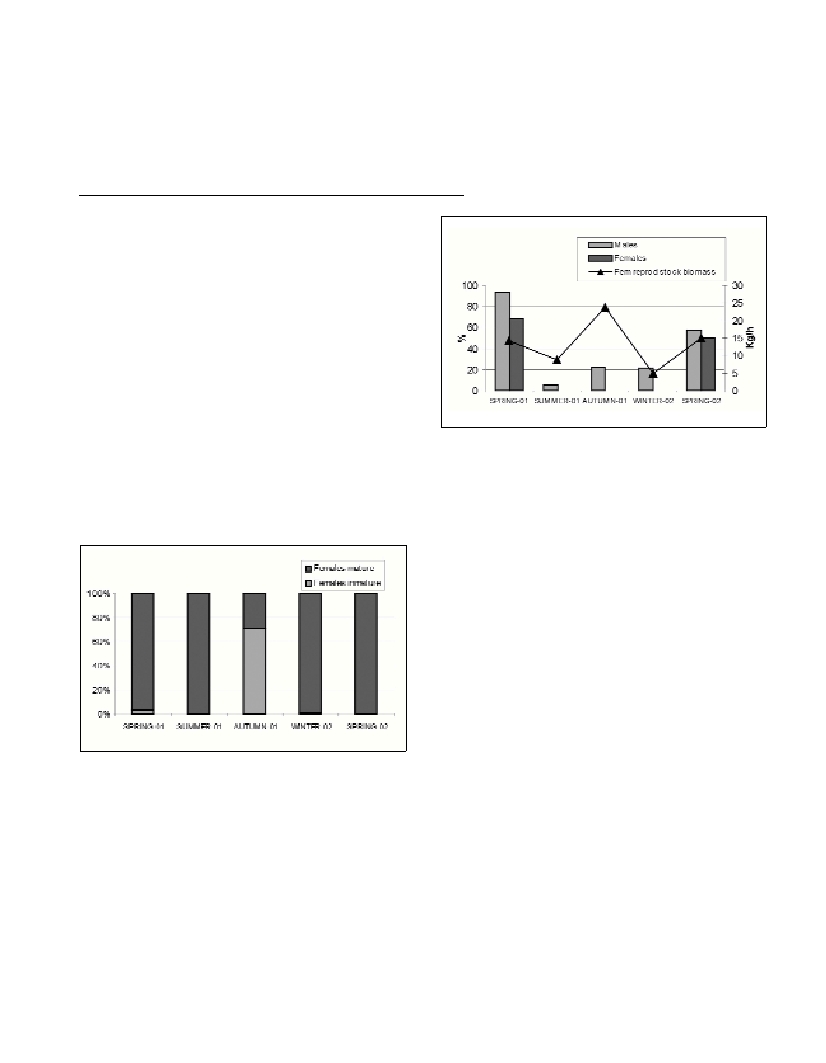REPRODUCTIVE ASPECTS OF RED MULLET (MULLUS BARBATUS)
IN THE ALBORAN SEA (WESTERN MEDITERRANEAN)
Del Árbol J., J. Rey and L. Gil de Sola*
Instituto Español de Oceanografía. Muelle Pesquero s/n. Málaga, Spain
Abstract
The spawning period, length at first maturity and reproductive biomass of red mullet (Mullus barbatus) in the Alboran sea (western
Mediterranean) were studied from data collected during five seasonal trawl surveys between 2001 and 2002.
Keywords: Red mullet, reproduction, spawning, Alboran Sea, Mediterranean
Rapp. Comm. int. Mer Médit., 37,2004
342
Introduction
Red mullet (Mullus barbatus L.) is a target species in the Alboran
Sea (western Mediterranean) where it is mainly captured with
trawlers, between 50 and 150 m, and gillnets in shallow waters. In the
present study, some aspects of the reproductive biology of red mullet
in the Alboran Sea were investigated.
Material and methods
Data were collected from five seasonal trawl surveys off the
Spanish littoral in the Alboran Sea carried out with R/V Cornide de
Saavedra andFco. de Paula Navarrobetween Spring of 2001 and
2002.
A total of 190 hauls were conducted between 40 and 796 m, using
a GOC73 gear with mesh size of 40 mm and based on stratified
random sampling (1). Total length (TL) at first maturity was
calculated using the least square method.
The sample sizes were: 107 (Spring 2001), 137 (Summer 2001),
457 (Autumn 2001), 169 (Winter 2002) and 213 (Spring 2002). The
average reproductive stock biomass was calculated by season
following Bertrand et al.(1)
Results and discussion
Most females (Fig. 1) and all males were premature or mature in all
sampling seasons, except the recruitment season (autumn), where
immature individuals predominated.
Fig. 1. Proportion of mature Mullus barbatusfemales in the Alboran Sea
between spring 2001 and 2002.
Among females, however, spawning individuals were only found in
spring (April-June). Males also presented a spawning peak in spring,
though a low proportion of ripping males were also found during the
rest of the year (Fig. 2). The total length (TL) at first maturity was
11.65 cm for males and 12.23 cm for females, both indicating an age
of 1 yr (2).
The average reproductive stock biomass calculated by season
(Spring 01, Summer 01, Autumn 01, Winter 02 and Spring 02) and sex
were: 12.053 (SE: 7.71), 14.685 (SE: 7.79), 18.347 (SE: 7.78), 4.62
(SE: 2.07) and 11.07 kg/h (SE: 4.99) for males and 14.095 (SE: 9.01),
8.819 (SE: 4.67), 23.876 (SE: 10.12), 4.85 (SE: 2.18) and 14.996 kg/h
(SE: 6.77) for females (Fig. 2).
These seasonal changes could be due to the migration pattern of the
species (3). The decline in the biomass of mature females could be
explained by migration either to shallow waters (<50m), where
trawling is not allowed, or to inaccessible rocky bottoms.
Fig. 2. Proportion of spawning Mullus barbatusin the Alboran Sea
between spring 2001 and 2002. Average female reproductive stock bio-
mass (>12 cm of length) is also shown.
References
1-Bertrand A., Gil de Sola C., Papacontantinou G. and Souplet A., 1998.
AN international bottom trawl survey in the Mediterranean: the MEDITS
programme. IFREMER Actes de colloques, 26: 76-93.
2-Livadas R. J. 1982. A study of the growth and maturity of striped
Mullet (Mullus barbatus L.) in waters of Cyprus. FAO Fish Report.,Vol
412: 44-51.
3-Suau P., Vives F. (1957) Contribución al estudio del salmonete de fango
(Mullus barbatus L.)del Mediterráneo Occidental. Investigación
Pesquera, 9: 97-118.

